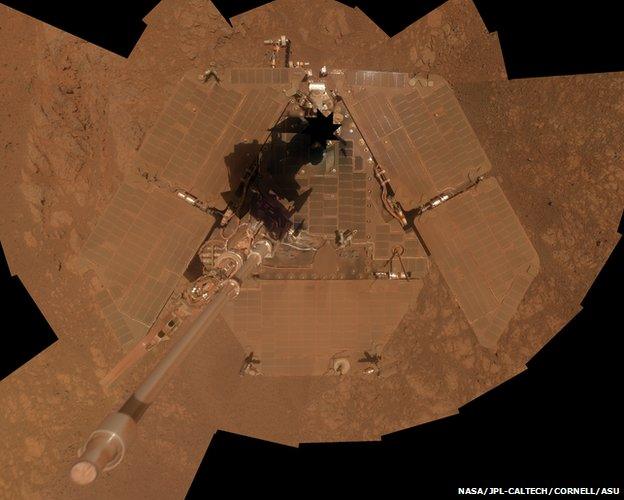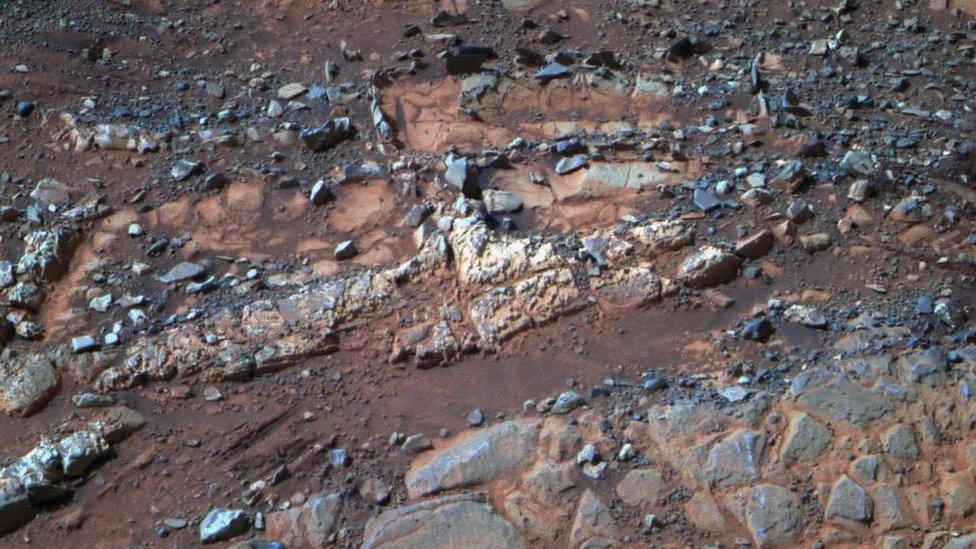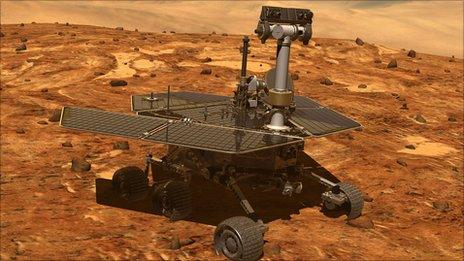Opportunity rover clocks 10 years on Mars
- Published
- comments

A birthday "selfie": Oppy uses its mast cameras to look down on itself
The American space agency (Nasa) is celebrating 10 years of operation for its Opportunity rover on Mars, external.
The six-wheeled vehicle landed on the planet's Meridiani plains on 25 January, 2004, at 05:05 GMT.
It has since trundled 38.7km across the surface, studying the local geology and returning over 170,000 images to Earth.
How much longer the rover can continue working in Mars' harsh environment is unknown, but Nasa is confident it will keep rolling a while yet.
"The rover has some degraded components," explains John Callas, the manager of the agency's Mars Exploration Rover Project, which looks after "Oppy", as it is often called.

Opportunity was the second rover landed on Mars in the space of three weeks
"The right-front steering actuator is jammed and no longer steers. The same wheel also shows elevated currents, the robotic arm has some arthritis, and two of the scientific instruments no longer function. But in the past year, almost nothing has changed in the health and status of the rover."
And it continues to deliver impressive research results.
To coincide with the anniversary, Science magazine has just published a paper, external detailing Opportunity's latest discoveries on the rim of the 22km-wide Endeavour Crater.
It has found evidence for clay minerals, which form in rocks that have been substantially altered by water.
In one place, these clays are of an iron-rich variety called smectite. In another location, Opportunity sees an aluminium-rich variety called montmorillonite.
They are contained in what are among the oldest rocks the rover has yet seen on the planet, probably four billion-plus years old.
It is further evidence, says the rover's deputy principal investigator, Ray Arvidson, that Mars was warmer and wetter in its distant past and had the potential, therefore, to support microbial life.
"If I were there back when this material was being emplaced and altered, and I had my summer house, this is where I would drill to get good drinking water," he jokes.
Smithsonian showcases Mars rover images
Recent days have produced a fascinating surprise for scientists with the sudden appearance of a small rock in the rover's field of view.
It has been likened by the team to a jam doughnut (or "jelly donut") because it has a whitish exterior and a reddish interior.
The rover team thinks the vehicle may have flipped the rock into view as it pirouetted on its wheels. Its chemistry was unexpected, containing a lot of sulphur, manganese and magnesium, says principal investigator Steve Squyres.
"We're still working this out; we're making measurements right now. This is an ongoing story of discovery. Mars keeps throwing new stuff at us. And it's these kind of discoveries that make this mission continue to be the exciting fun thing that it is."
The road ahead will see Opportunity try to climb a ridge at Endeavour to get to a place dubbed Cape Tribulation. Orbiting satellites have indicated there may be more clays to examine at this location.
The rover project costs about $14m (£8.4m) a year to run. It must endure a review later this year where it must compete with other Nasa missions for ongoing funding.
Given the pressure on the agency's budget, it is likely that some ventures that are still working will have to be switched off.
"Frankly, all the missions we have are very productive and it would be a shame not to have enough for a continuation of all those missions. But we'll see how that turns out when we get to the senior review," says Michael Meyer, the lead scientist on Nasa's Mars exploration programme.
The twin rover, Spirit, which landed three weeks prior to Opportunity, was declared dead by Nasa in May 2011. It had become stuck in soft sand in 2009, and then eventually ceased communicating with Earth. Engineers think the extreme cold probably damaged many critical components and connections on the robot.

Two images taken 12 days apart show the sudden appearance of the "jelly donut"
- Published24 January 2014

- Published9 January 2014

- Published10 June 2013

- Published7 December 2012
- Published25 May 2011
